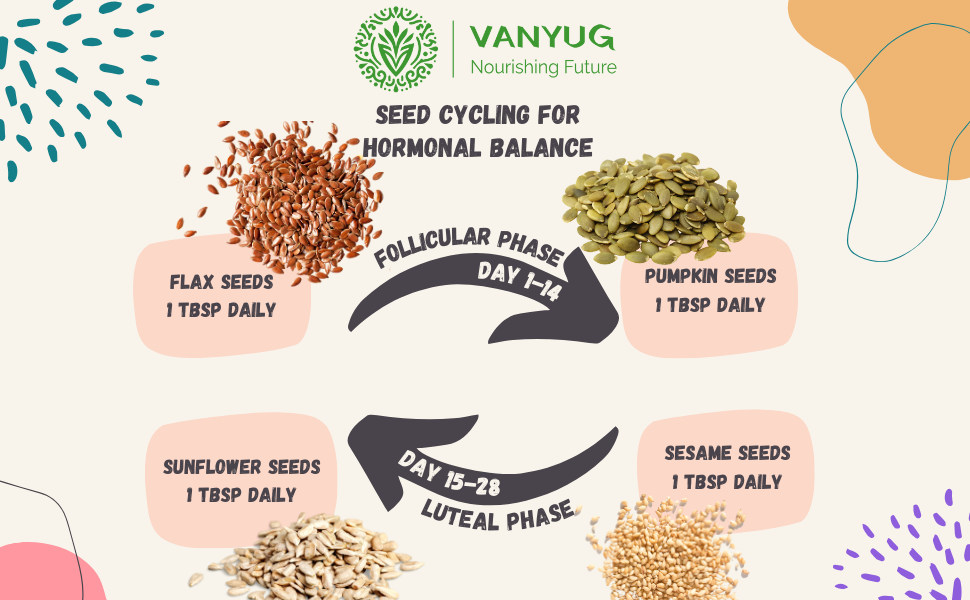The Benefits of Seed Cycling: A Natural Approach to Hormonal Balance
In the world of holistic health, seed cycling has emerged as a gentle and natural method to support hormonal balance. By incorporating specific seeds into your daily diet, seed cycling aims to promote hormone harmony throughout the menstrual cycle. Let’s delve into the science, benefits, and practical steps to get started.
What is Seed Cycling?
Seed cycling is a dietary practice where specific seeds are consumed during different phases of the menstrual cycle to support hormone production and regulation. The practice involves:
- Follicular Phase (Day 1 to Day 14): Incorporating flaxseeds and pumpkin seeds to promote estrogen production.
- Luteal Phase (Day 15 to Day 28): Including sesame seeds and sunflower seeds to support progesterone production.
Each seed is rich in nutrients and compounds believed to have hormone-modulating properties.
How Does Seed Cycling Work?
The seeds used in seed cycling contain lignans, essential fatty acids, and other nutrients that may influence hormone levels:
- Flaxseeds: High in lignans, which may help modulate estrogen levels and support detoxification of excess estrogen in the body.
- Pumpkin Seeds: Rich in zinc, which plays a role in progesterone production and ovulation.
- Sesame Seeds: Contain lignans and healthy fats, supporting progesterone production during the luteal phase.
- Sunflower Seeds: Packed with selenium, a nutrient vital for liver function, which helps process hormones effectively.
Potential Benefits of Seed Cycling
While more scientific research is needed to validate seed cycling, anecdotal evidence and nutrient profiles suggest it may help with:
- Hormonal Balance: Supporting regular menstrual cycles and alleviating symptoms like PMS, irregular periods, and hormonal acne.
- Menopause Support: Helping manage symptoms such as hot flashes and mood swings.
- Bone Health: The calcium, magnesium, and healthy fats in seeds contribute to stronger bones.
- Digestive Health: High fiber content supports gut health, which is integral to hormone regulation.
How to Start Seed Cycling
Follow these steps to incorporate seed cycling into your routine:
- Track Your Cycle: Begin on the first day of your menstrual cycle. If you have irregular cycles, use the lunar calendar as a guide, starting the follicular phase on the new moon.
- Choose Organic, Raw Seeds: Opt for organic, raw, and freshly ground seeds for maximum nutrient retention.
- Daily Dosage: Consume 1 tablespoon each of the appropriate seeds per phase:
- Follicular Phase: 1 tbsp flaxseeds + 1 tbsp pumpkin seeds daily.
- Luteal Phase: 1 tbsp sesame seeds + 1 tbsp sunflower seeds daily.
- Incorporate Creatively: Add seeds to smoothies, oatmeal, salads, or homemade energy bars.
Who Can Benefit from Seed Cycling?
Seed cycling is suitable for individuals experiencing:
- Irregular menstrual cycles
- PMS symptoms
- Hormonal acne
- Perimenopause or menopause symptoms
It can also be a preventive practice for maintaining overall hormonal health.
Important Considerations
- Consult a Professional: If you have specific health conditions or are on hormone-related medications, consult a healthcare provider before starting seed cycling.
- Patience is Key: Hormonal balance takes time. Allow 3-6 months to observe noticeable changes.
- Complementary Practices: Combine seed cycling with a balanced diet, stress management, and regular exercise for optimal results.
Final Thoughts
Seed cycling offers a natural, food-based approach to supporting hormonal health. While it may not replace medical treatments, its nutrient-dense seeds can complement a holistic wellness plan. Whether you’re navigating PMS, menopause, or simply aiming for balanced hormones, seed cycling is a simple, nourishing practice to consider.
FAQs About Seed Cycling
1. Can seed cycling help with PCOS? Yes, seed cycling may support hormonal balance in individuals with PCOS by promoting regular cycles and reducing symptoms.
2. Can men benefit from seed cycling? While primarily targeted at women, the nutrient-rich seeds can support overall health in men, including prostate health and hormone metabolism.
3. How long does it take to see results? It’s recommended to practice seed cycling for at least 3-6 months to observe noticeable changes.
4. Can I use seed cycling if I’m postmenopausal? Yes, seed cycling can be adapted to support hormonal health and alleviate menopausal symptoms.
Disclaimer: This article is for informational purposes only and does not constitute medical advice. Always consult with a healthcare provider for personalized guidance.
Sources

